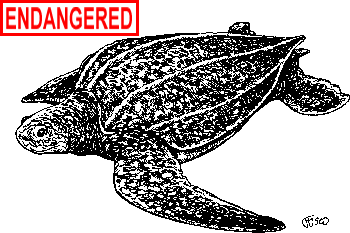Leatherback Sea Turtle
Dermochelys coriacea

Habitat: Found near the edge of the continental shelf. In northern waters, it may enter shallow estuarine bays.
Weight: 650-1,200 pounds.
Length: 5-6 feet; record is 9 feet. Flipper span is enormous, about 9 feet on a 7-foot turtle.
Life Expectancy: Actual documentation of age is rare. Lifespan is estimated to be 50 years or more.
Food: Mainly jellyfish, but also sea urchins, crustaceans, squid, fish and floating seaweed.
Status: Federally and state endangered.
Identification: The leatherback has a smooth shell covered with skin and lacking horny scutes (plates). The dark brown to black carapace (top shell) is elongated and triangular, and divided by 7 longitudinal keels (ridged scales). Irregular patches of white may appear almost anywhere; white is predominant on the plastron (bottom shell). The black limbs are paddle-like and clawless. Young leatherbacks are black, with more conspicuous white markings than adults.
Range: This highly migratory turtle can be found in the tropical Atlantic, Pacific and Indian Oceans and the Mediterranean Sea from as far north as the British Isles to as far south as Australia. In the United States, the species nests mainly along the Florida coast, but nesting has been documented as far north as North Carolina.
Reproduction: Leatherbacks mate offshore in shallow waters near the nesting area. The females dig their flask-shaped nests at night on sloping sandy beaches backed by vegetation. Six clutches can be laid in a season, with a 10-day period between nesting. The females may renest up to 7 miles from the first nest. An average clutch contains 80 to 85 eggs and incubation takes from 55 to 74 days. The 3-inch hatchlings emerge at night and head toward the ocean. The turtles reach sexual maturity at 6 to 10 years of age; the females nest every second or third year.
Reason for Decline: Leatherback turtle populations have historically declined due to overharvesting for food, fish bait and turtle products. They are also limited by deaths from oil spills, entanglements in lobster pots, beach traffic, predation and nest flooding. Boat propellers, which often inflict serious wounds to sea turtles, have been responsible for many turtle deaths. Commercial fishing and shrimping activities often cause turtles to drown or become mutilated or entangled in nets. Fortunately, by 1994, federal regulations will require that all shrimp trawlers in the Gulf of Mexico and the Atlantic Ocean use turtle excluder devices (TEDs) year round.
Discarded plastic bags and wrappers, helium balloons and monofilament fishing line that end up in the ocean can also be deadly to sea turtles, as well as to other marine life. Balloons and plastic bags, when floating in water, resemble the turtles' main prey, jellyfish. When turtles mistakenly eat these items or fishing line, their digestive system becomes blocked and they eventually die. Another factor which affects sea turtle populations is the presence of lights on beach nesting areas. After hatching, the small hatchlings head for the light along the horizon and light reflected off the surface of the ocean. Inland lights can confuse their orientation, causing the hatchlings to head inland rather than out to sea.
Nesting areas on Atlantic beaches are threatened by recreational and industrial development and beachfront construction.
History in Connecticut: The leatherback may occur in concentrated numbers in the Northeast. Turtles are frequently observed off Stonington and in Block Island Sound during the summer months.
Interesting Facts: The leatherback is the most ancient species of living sea turtle, as well as the largest and heaviest turtle in the world.
The leatherback's proportions and streamlined shape are advantageous for long distance swimming.
Although turtles do not have teeth, this species has a well-defined projection on each side of the upper jaw. The jaw is used to hold and cut soft-bodied prey (jellyfish). The mouth and esophagus are lined with long, backward-projecting spines that help the turtles swallow jellyfish. The leatherback can even eat the Portuguese man-of-war jellyfish whose poisonous nematocysts (stinging organs) are dangerous to humans.
The species has the extraordinary ability to maintain a warm body temperature in cold water. Although this adaptation is not necessary for leatherbacks to live in tropical waters, it enables the turtle to survive in temperate and cold-temperate latitudes. Leatherbacks are pelagic (live in the open ocean) except when nesting on tropical and subtropical beaches. They seem to follow jellyfish migratory patterns, seasonally moving north along the Atlantic coast as far as Canada, then inshore and back south in autumn through the bays and sounds of New England. They winter in the Gulf of Mexico and along the Florida coast.
Protective Legislation: Federal - Endangered Species Act of 1973, CITES (Convention on International Trade in Endangered Species) Appendix I. State - Connecticut General Statutes Sec. 26-311.
What You Can Do: You can help sea turtles by not purchasing illegal turtle products, such as turtle leather and tortoiseshell items, and by properly disposing of or recycling plastic bags, fishing line and balloons. In an effort to help curb the problem of balloons in Long Island Sound, Connecticut has passed legislation limiting helium balloon releases to no more than 9 in a 24-hour period. With the help of a little wind, even balloons released in Connecticut's inland areas can end up in the Sound.
Many sea turtles are tagged for research with metal or plastic markers. Tags are usually on the inside edge of the front flippers; sometimes the rear flippers or the shell may be tagged. If you observe a tagged turtle, do not remove any tags unless the turtle is dead. Tag numbers should be reported to the address on the tag or to the Wildlife Division's Nonharvested Wildlife Program at deep.wildlife@ct.gov or call 860-424-3011.

The production of this Endangered and Threatened Species Fact Sheet
Series is made possible by donations to the Endangered Species/Wildlife Income Tax
Checkoff Fund.
(rev. 12/99)

